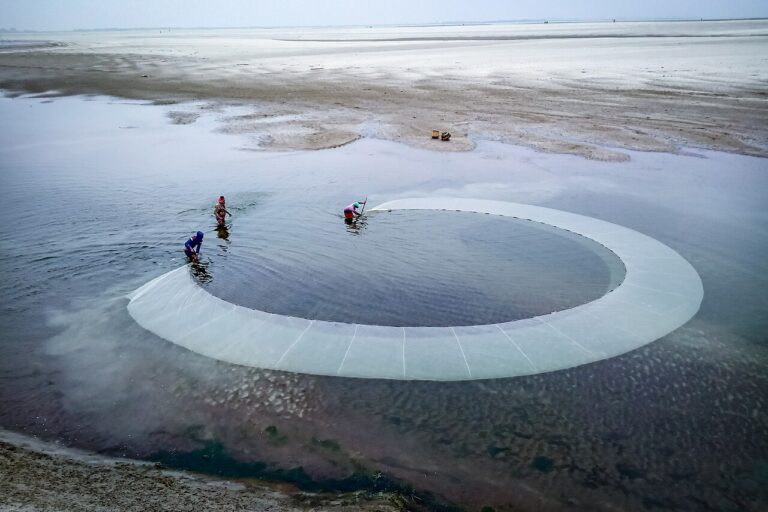- Past research on sharks and rays in India lacks relevance to their conservation and management.
- Studies were biased towards the states of Tamil Nadu and Kerala and towards charismatic species. Rays are understudied and researchers say more research on rays is needed.
- Experts recommend future studies on regional species stock assessments, critical habitats and socioeconomic drivers of fisheries, among others.
- Funding should be allocated to applied research and greater collaboration opportunities are needed, say experts.
Ancestors of sharks have been swimming in the oceans for as long as 400 million years, fossil evidence suggests. With over 1000 species of sharks and rays worldwide, they come in a wide range of sizes and shapes. These skillful top predators play vital roles in marine ecosystems. Yet, a third of all known species of sharks, rays and chimaeras — comprising a group of cartilaginous fishes called chondrichthyans — are threatened with extinction due to overfishing and other human activities.
A new study analysing past research on sharks and rays in India found that most studies concentrated on a few states and on charismatic species. Overall, research lacked relevance and applicability to chondrichthyan conservation, specifically on-ground management and policy-making. The team, along with other experts, recommended more funding allocation into applied research and greater collaboration opportunities.
India has one of the largest chondrichthyan fisheries globally and boasts a high diversity of species—at least 155—in its waters. In the Arabian Sea and adjacent waters, which were found to host 30 endemic species, the plight of chondrichthyans is particularly dire: over 50 percent are threatened, mainly due to overfishing.
Management of fisheries
Compared to other Asian countries, India has few policies and regulations to conserve sharks and rays. Currently, ten species of sharks are protected under Schedule I of the Indian Wildlife (Protection) Act, 1972. In 2015, shark finning and the import and export of shark fins was banned.
“While these are positive steps, a lot more needs to be done,” says Trisha Gupta, lead author of the study and a doctoral student at the University of Oxford. “India does not yet have a National Plan of Action (NPOA) for sharks, unlike many other shark-fishing countries in Asia. A draft NPOA was submitted to the Ministry of Environment, Forests and Climate Change in 2015, but has not yet been adopted. Adopting and implementing the NPOA will be the first step in developing effective conservation policies for sharks and rays in India.”
“India is one of the biggest fishing nations in the world, yet most of its shark and ray species are facing a very high risk of extinction with several species already locally or regionally extinct,” says Nicholas Dulvy of Canada’s Simon Fraser University. “These patterns of decline forewarn of serious problems with the state of India’s fisheries,” Dulvy, who was not involved in the study, notes. “Sharks and their ecosystem and socioeconomic value require investment to secure their future value and to steward the benefits of biodiversity and humankind.”

Management of fisheries worldwide has been undergoing a paradigm shift from focusing on a single species to a more holistic ecosystem approach, which combines concepts of conserving biodiversity along with food security and livelihoods. It is, however, more challenging to implement in practice, Gupta notes.
“Even though India’s shark production figures among the top three nations globally, the group contributes to only 1-2 percent of the annual marine fish landings in the country,” explains Shoba Joe Kizhakudan, principal scientist at the Central Marine Fisheries Research Institute, Chennai. “There is no large-scale exclusive targeted fishery for sharks and rays, except in certain pockets and seasons and most of the landings are as bycatch of other fisheries. Given India’s multi-gear, multi-ground, multi-species fisheries, devising and implementing fishery management plans for any one resource is a very challenging task.”
In 2021, Gupta and her colleagues conducted a scoping review of existing scientific and grey literature on sharks and rays in India. The aim was to find the main themes covered in chondrichthyans research in India; the region of distribution of the research; the taxa of focus; and if the data reported has recommendations for chondrichthyan management.
The number of publications increased exponentially over time, with almost half of all chondrichthyan studies — 219 — published in the most recent decade (2011–2020), compared with only 90 in previous decade. While this is a positive sign, say the researchers, the literature mostly consists of “short-term fisheries studies, biological records and observations, with less than 10 percent of studies addressing socio-economic and management themes.”
Focus on some states and charismatic species
Regionally, research was biased to the states of Tamil Nadu on the southeastern coast of India and Kerala on the southwestern coast. According to the researchers, the presence of governmental research institutes in these states might explain the bias. For example, the Central Marine Fisheries Research Institute (CMFRI) is a research institute under the Indian Council of Agricultural Research with its headquarters in Kerala and major research centres in Tamil Nadu. Also, seafood consumption is known to be high in Kerala, including sharks and rays, while Tamil Nadu has one of the highest levels of chondrichthyan fishing.
Kizhakudan of the CMFRI, who was not involved in the study, agrees that most studies are undertaken by government institutes. “CMFRI’s studies are by and large fishery-dependent and collection of data is sometimes limited by external criteria such as accessibility to resources and community amenability,” she says.
“While sharks are not a main targeted resource in India’s fisheries, they command consumer demand, good market value and are therefore highly valued even as by-catch,” Kizhakudan explains. “In several regions, a lot of traditions and cultural significance is also linked to these fishes.”
Apart from Tamil Nadu, Gupta says there is scant research on India’s eastern coast. “There is evidence for targeted shark and ray fishing in Andhra Pradesh, as well as high local consumption,” notes Gupta. In 2015, Gujarat and Maharashtra located on India’s western coast together contributed 54 percent of India’s shark landings. “While there is some literature on sharks and rays in Gujarat, as our study finds, most of this research has focused on the whale shark (Rhincodon typus),” says Gupta. “There are very few studies on other species, despite Gujarat’s high landings of sharks and rays.” More research is needed in Andhra Pradesh and also in states such as Gujarat and Odisha, Gupta asserts, adding that smaller states and union territories such as Goa and Lakshadweep should not be overlooked despite having a low contribution to shark harvest.
The analysis also showed that research focused on ‘charismatic’ species such as the whale shark. Charismatic species attract more attention because they are species that are considered beautiful, rare, impressive or dangerous, Gupta explains. “This is the same with sharks: the species that are larger or more iconic have been better studied, like the whale shark, as our paper finds.”

Compared with sharks, rays are less charismatic, says Gupta, which explains why research and conservation efforts towards these species are lower. “Rays are highly diverse, with a large number of species, many of which are poorly described. Rays also form important components of the fisheries on the east coast. Hence, it’s important that rays in India are better studied.”
A 2015 study, which compiled data from three chondrichthyan-focused international conferences spanning 23 years (1991, 2010 and 2014), also found a bias towards charismatic species. Rays represented 9 percent of the contributions while chimaeras were less than 2 percent. Consequently, the researchers also suggested greater research attention towards these species.
“Taxonomic biases or over-representation of some research topics has been documented in other countries and across various fields of research,” says Charlie Huveneers, professor at Flinders University and lead author of the 2015 study. “It is essential to ensure that resource use is prioritised based on needs and relevance to management, especially where resources are limited.”
Research priorities for conservation and funding issues
Gupta and her colleagues made recommendations for applied research to guide conservation. Future research should focus on identifying vulnerable species for conservation through regional species risk assessments; determining areas for conservation based on habitat-use and aggregation sites especially sites used for spawning, nurseries and feeding; developing successful management measures by understanding socioeconomic drivers of chondrichthyan fisheries; and improving conservation measures by reviewing existing policies and regulations for chondrichthyans in India.
In the 2015 Guidance on National Plan of Action for Sharks in India, Kizhakudan and her colleagues from the CMFRI have “set out all these recommendations and more concerning research, management, conservation and socioeconomic aspects,” says Kizhakudan.
One issue, Gupta highlights, is the allocation of existing funds and research efforts. “We need to re-evaluate the way research is conducted, and prioritise key issues, allocating funding and effort to more applied research,” she suggests.
“Papers like this are important for quantifying the current focus and set an agenda to drive national and international funding priorities,” says Dulvy. He identifies three key issues with research on sharks and rays. “First, researchers are limited by funding and funding priorities, which can follow political or industrial or conservation fads. Second, researchers most often study the most common species which inevitably means that the most endangered species are woefully understudied. Third, tractable research questions often centre on the latest technologies (tagging, eDNA, stable isotope analyses). Hence, there is often lack of fundamental data collection needed to tackle questions like,” what species are present, where do they live, in what abundances, and what is the mortality due to threats such as overfishing.
Most studies on the biology and stock status of sharks and rays in India focus on smaller species due to access issues and financial considerations, Kizhakudan points out. “Consistency in landings (or lack of it), high cost and lack of fishery-independent survey programmes focused on sharks and rays,” are some reasons for this, says Kizhakudan, adding that “most of the sharks and rays that form a major share in the fishery of the group are smaller-sized, coastal species and hence are relatively better available for detailed studies.”
Acknowledging that “major gaps in information on critical habitats, ecology, aggregation and migration details of sharks in Indian waters exist,” Kizhakudan says “there is not much access to suitable research grants and collaborations.” Moreover, “ecological studies are limited as they involve high operational costs and most funding agencies consider these as basic studies.”

David Shiffman, a marine conservation biologist at Arizona State University, who was not involved in the studies, says, “International NGOs and scientists should do more to partner with and fund scientists in India while listening to what they say they need.”
The 2015 analysis of three international conferences found that no delegates from India attended the conferences in 1991 and 2014, while very few attended the conference in 2010. The researchers urged greater support for scientists from low-income countries.
Stressing the importance of involving fishers, Gupta says, “not only can they assist in the research of sharks, they also are the main stakeholders and can form vital champions of marine conservation.
Over the past two decades, Indian Ministries have been directing efforts towards shark research, conservation and management, Kizhakudan says, noting that stakeholder participation and linkage between organizations has increased.
In February 2020, experts in the first National Consultative Workshop on Threatened and Protected Elasmobranchs organised by the CMFRI, suggested changes in conservation attention on marine fauna in general including sharks and rays and recommended improved research collaborations and multidisciplinary research. “However, the timeline involved in realising this may or may not be protracted,” Kizhakudan points out.
“The ‘way forward’ is already happening in India and we are on the right track,” says Kizhakudan. “Though there is a long road ahead, I have no doubt that India’s shark conservation strategies will be in line with FAO’s International Plan of Action for Conservation and Management of Sharks and global actions very soon.”
Read more: India’s sharks and rays: an ancient species on the brink of extinction
CITATION:
Gupta, T., Karnad, D., Kottillil, S., Kottillil, S., & Gulland, E. M. (2022). Shark and ray research in India has low relevance to their conservation. Ocean & Coastal Management, 217, 106004.
Huveneers, C., Ebert, D. A., & Dudley, S. F. (2015). The evolution of chondrichthyan research through a metadata analysis of dedicated international conferences between 1991 and 2014. African Journal of Marine Science, 37(2), 129-139.
Jabado, R. W., Kyne, P. M., Pollom, R. A., Ebert, D. A., Simpfendorfer, C. A., Ralph, G. M., … & Dulvy, N. K. (2018). Troubled waters: Threats and extinction risk of the sharks, rays and chimaeras of the Arabian Sea and adjacent waters. Fish and Fisheries, 19(6), 1043-1062.
Karnad, D., Sutaria, D., & Jabado, R. W. (2020). Local drivers of declining shark fisheries in India. Ambio, 49(2), 616-627.
Banner Image: Two brown-banded bamboo sharks (Chiloscyllium punctatum) at the Aquarium of the Pacific in California. Photo by Coughdrop12/Wikimedia Commons.














